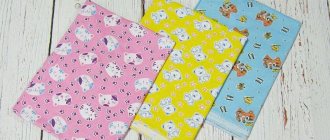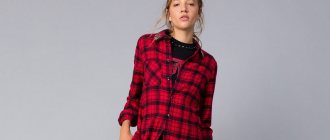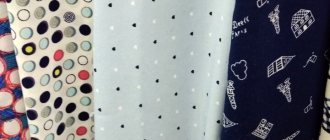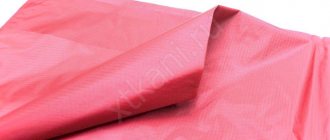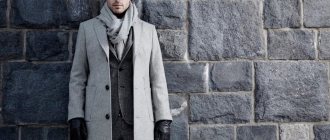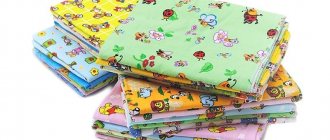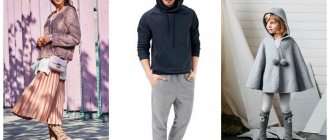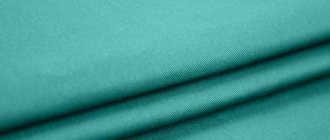Home / Natural fabrics
Back
Published: 02/04/2021
Reading time: 3 min
1
95
Flannel is a fabric that has been familiar to us since early childhood. Caring mothers wrapped us in cozy flannel diapers and put on warm dresses, shirts and pajamas. As adults, we continue to enjoy wearing products made from this comfortable, soft material, which immerses us in an atmosphere of warmth and comfort.
- 1 Place and history of origin
- 2 What does flannel look like?
- 3 Manufacturing and properties
- 4 Types of material 4.1 By composition
- 4.2 By processing and coloring technique
- 4.3 Intended use
A brief excursion into history
England is considered the birthplace of the fabric. Flannel first appeared in Wales in the 16th century. Initially, the basis was pure wool. It was this composition that contributed to the popularity of the material. It was considered medicinal. This was especially true for red varieties.
The Welsh had their own secrets of trade. Multi-colored canvases were highly valued. But they were not painted. During the production process, threads of different shades were intertwined in certain proportions: blue, white, red, brown, black. If it was desired to obtain light shades, dark wool fiber was bleached with sulfur dioxide.
In Russia, the new product appeared 3 centuries ago. It was brought by the reformer Tsar Peter the Great. At first, the material was appreciated by the soldiers, since at first the fabric made from sheep’s wool was used to sew foot wraps. The loose structure ensured good air exchange, and the fibers provided softness. The rough tarpaulin did not chafe their feet, and the servicemen felt quite comfortable in their boots.
In our country, the healing abilities of flannel were also appreciated. There are documented references to doctors who treated the royal family. The name of the fabric can also be found in the works of V. Dahl.
At the dawn of its appearance in England, the material was used mainly for the manufacture of sportswear. Since 1924, a new era in the life of flannel began. Business suits began to be made from it. It is associated with the Prince of Wales. For his visit to America, he chose a flannel suit. And without thinking about it, he turned clothing into a fashion trend that held a leading position in the business wardrobe until the middle of the last century. Today, the fashion for flannel suits is returning.
The English classic Jonathan Swift, who told the world about the adventures of Gulliver, also mentions the treatment of joints with soft, warm fabric. The procedure is simple: the source of inflammation was rubbed with cognac and wrapped in flannel.
Varieties
When talking about what flannel is, people sometimes mean different fabrics. Although they all have a similar nature, they may differ in appearance. There are several types of material.
According to the production method and the fibers used, it is divided into three types:
- Swanskin;
- Cotton;
- Wool blend.
According to the methods of staining, the following are distinguished:
- Plain-colored;
- Printed;
- Bleached flannel.
The list is not limited to this. In addition to this there is:
- Severe flannel is a dense material used for technical needs.
- The so-called children's room. This is bleached flannel. It is distinguished by the presence of a small pattern on a light surface. Most often used for sewing bed linen.
- Shirt. It has a printed pattern in the form of stripes and cells. It is this variety that is the most recognizable. For many, such a pattern is the main distinguishing feature of the material, although this is not true.
Despite the diversity of species, they all have similar characteristics, so the relationship is recognizable.
Compound
“Classic” flannel is made from wool. The Welsh could not imagine any other raw material for this fabric. Today it is not only woolen, but also half-woolen. However, most often the fabric consists of cotton. Moreover, the fibers are heterogeneous, which is why the traditional brushed appearance is achieved.
The basis is medium-fine carded yarn with a thread density of 42-60%. For weft, hardware yarn is used - more voluminous. Relative fiber density 53-60%. Viscose can be added to natural raw materials. In this case, the final textile product acquires a slight shine. Synthetic fibers can also be chosen as additives.
Weaving methods are different: plain, rapeseed, twill. The latter can be recognized by the sparse fleece on both sides, through which the thread pattern is visible. By the way, the pile can be evenly distributed both on one side and on the face and back at the same time.
Care Tips
Flannel is a fabric that can maintain a neat appearance for a long time if you properly care for these textiles.
Cotton fabric requires the following care:
- This fabric can be washed by hand or in a machine at a temperature of 60-90° C.
- Do not use bleaches containing chlorine; special stain removers are recommended.
- To maintain the softness of the pile, there is no need to rub the fabric when washing.
- Products are dried away from heating devices, avoiding exposure to direct sunlight.
- Iron the fabric using the “Cotton” mode.
- A tablespoon of glycerin added during washing will help maintain the softness of the material.
Caring for wool flannel is much more difficult:
- The water temperature when washing is no more than 30-40° C, otherwise the fabric will shrink and the size of the items will decrease.
- It is advisable to use wool detergents.
- When drying, do not allow exposure to sunlight.
- Iron using a setting designed for woolen items.
- The rinse water should be at the same temperature as when washing.
If you follow these simple rules, things made of flannel fabric will warm their owners for a long time with their warmth, tenderness, and care. The products are pleasant to wear, since this material with a soft fleecy surface does not cause discomfort when in contact with the body.
Types of flannel
The modern textile market offers several varieties. All of them have high performance indicators, but may differ in the technologies used in the production process.
| Species name | Description |
| Harsh | An ordinary, slightly rough-looking canvas that has not been subjected to any processing. Belongs to the category of technical fabrics. Used as napkins for wiping items. Can be used in industry. For example, in the production of musical instruments. The hammers in the piano are upholstered with flannel fabric. |
| Bleached | Subjected to bleaching at the initial stage of production. The cotton plant from which the fabric is made is not always white. Often it has other shades. To give whiteness and uniform coloring, the material is bleached. Can be used in snow-white form for sewing bedding, children's clothing, or dyed in different shades in the future. |
| Belozemelnaya | One of the varieties of bleached flannel. A drawing is applied to a perfectly white background. It can be small or large. |
| Unpaved | The second type of bleached material. It also has prints on one side. But they are not applied to a snow-white surface, but to a pre-painted one. |
| Plain painted | This kind of textile is quite common. Has a single color on both sides. A characteristic feature is that it is not the finished fabric that is dyed, but individual threads. That is why this coloring is durable, uniform, and has no sharp transitions. This variety is in demand for sewing suits, coats, and home wear. |
For both white-earth and soil varieties, dyes are usually applied to the outside. This ensures safety and allows you to choose natural fabric even for children, allergy sufferers, and people with sensitive skin. The paint does not come into contact with the skin, which means that the risk of a negative reaction (redness, rash) is minimal.
Types by application
Textile workers distinguish 2 large groups. This:
| Shirt flannel. | Characteristic features are small pile and increased density. Artificial fibers and synthetics can be added to the composition. This variety can be recognized by its prints - checkered, less often - stripes. The popularity of shirt fabric has its ups and downs. The first peak was observed a century ago - in the 20s. The material was placed on a pedestal by fans of the beat movement, led by Jack Kerouac. The second peak is the 90s of the last century. Shirts owe their increased interest to Kurt Cobain. Today, such wardrobe items are preferred by the male audience, who choose an informal style of clothing. |
| Negligent. | Is in stable demand. Its demand increases especially in the off-season and winter seasons. The name of the category is quite arbitrary. This fabric is used for sewing not only dressing gowns, but also home dresses, nightgowns, pajamas, and children's products. Warm, soft clothing warms you well and gives you comfort, a feeling of calm and relaxation. Distinctive touches are a pattern on a colored (very rarely on a white) background, high density, one-sided or double-sided combing. |
Despite the fact that it is customary to distinguish only 2 groups, other things are also sewn from flannel.
Types by density
Flannel is a fairly heavy fabric. Weight can be up to 400 g per meter. But this is not its only difference. The material is not uniform in density. There are varieties on sale with different indicators:
- light - 160 g/sq.m. meter;
- average 175-258 g/sq.m. meter;
- heavy – 270 g/sq.m. meter.
The scope of use for each group is different. Textile with a density of 270 g/m2. meter is chosen for the production of outerwear: coats, warm suits. Shirts, bathrobes, and bed linen are made from other analogues.
For reference: Production of materials is established in different countries. In Russia, canvases made in the Ivanovo region and analogues from China are popular.
What can diaper inserts be made from?
Inserts are needed to quickly absorb liquids when the baby goes to the toilet. Therefore, the main rule for the material from which the mother is going to sew inserts is fast absorption. Of course, you should pay attention to the composition of the fabric: there should be no synthetic materials. After all, the insert comes into contact with the baby’s intimate places, where the skin is very delicate and irritation, rash and itching can quickly form. All this will cause discomfort to the baby. Therefore, the following materials are best suited for making liners:
- gauze: we have already talked in detail about the properties of this fabric. Gauze folded in four layers is an excellent option. It is recommended to discard such liners immediately after use, since after washing the fabric pieces quickly lose their shape. It is better to use a new cloth for the next use;
- madapolam: also a worthy option. Some mothers use such liners reusably, since this material is stronger than gauze and holds its shape better after washing;
- microfiber: although this is not a completely natural material, it quickly absorbs moisture and does not cause irritation;
- flannel: soft fabric will not cause discomfort to the baby, and also perfectly absorbs moisture;
- Bamboo Fabric: Many moms use old bamboo towels to make diaper inserts. This option also exists. But it is better to give preference to towels in light colors.
The earbuds can be simply rolled or sewn to prevent them from bunching up during use.
The process of sewing a liner with your own hands
- A piece of fabric measuring about 30x40 cm needs to be folded several times: three or four layers.
- You should get a rectangle that will fit between the baby's legs.
- It is better to round the edges of the fabric, so the insert will be more comfortable: the corners will not bend and interfere with the child.
- The best way is to overlay the edges along the entire length of the liner or sew a zigzag seam twice.
- The liner must be ironed before use.
You can buy the inserts; you don’t have to sew them yourself. They are sold in packs of different quantities and are not very expensive. The best ones today are those made from dark bamboo fabric.
What types of diaper inserts are there - video
Let's get to know each other better: main characteristics
Flannel has won the recognition of millions of consumers thanks to its performance indicators. Among them:
- High density. Depending on the composition and production method, it can vary from 160 g/sq. meter up to 270 g/sq. meter.
- Breathability. This is explained by the arrangement of the fibers in relation to each other. The structure of the fabric is loose. Therefore, air can circulate freely. This provides comfort and eliminates excessive sweating and the greenhouse effect.
- Hygroscopicity. The material absorbs moisture well, while retaining it in the fibers. The risk of irritation is reduced to zero.
- High heat saving. The spaces between the threads trap the heat generated by the human body. Therefore, it is never cold in such things.
- Hypoallergenic. Material made from natural cotton raw materials is safe even for asthmatics and allergy sufferers. But you need to be careful with wool and wool blend varieties.
Note: The sizes of cuts (their width) produced by manufacturers vary. For diapers, varieties with a width of 80-90 cm are used. For other products - 150-220 cm.
Standard diaper sizes
All diapers have a simple rectangular shape. The baby is laid on the long side, and the baby is wrapped with the short side. The diaper size can be standard, large or small. It depends on the height and weight of the child. The larger the child, the more diapers are needed.
For newborns, a diaper 85 to 90 cm wide by 120 cm long is considered a standard size. It easily swaddles a baby weighing 3-3.5 kg and up to 52 cm tall. But if the child is large, then you need to increase the size of the diaper.
You need to add 10 cm in width for every additional half a kilo of weight and 3 cm of height of the baby. The length of the diapers does not change. So for a child weighing 4 kg and height 55 cm, diapers 110 cm by 120 cm will be needed.
Diaper sizes according to weight:
| Approximate baby weight, kg | 2,5 | 3 | 3,5 | 4 | 4,5 |
| Diaper dimensions, cm | 85x120 | 90x120 | 100x120 | 110x120 | 120x120 |
It must be taken into account that the baby will grow rapidly in the first months after birth. If you plan to swaddle your baby up to 3-4 months, then it is better to make the diapers larger, leaving a margin of 10 cm.
In a nutshell about a bright palette
Immediately after its appearance, flannel was associated only with light shades. The enterprising British wanted variety and discovered several ways to change colors: weaving multi-colored threads and dyeing.
Today on sale there are cuts from light (even whitish) to deep dark tones. Print lovers are not short of choice. The most common one for shirts is plaid. Among the options for men's clothing there are striped patterns. In women's and children's clothes, floral motifs, abstractions, funny emoticons, and cartoon characters often predominate.
Benefits of sewing diapers with your own hands
Handmade diapers for newborn babies are of high quality and durable. After all, they are sewn more neatly. The whole process of sewing diapers takes very little time.
A big advantage of this type of work is the independent choice of the quality and type of material, color and pattern. By choosing the fabric yourself, you can be sure of its safety, durability and naturalness.
The cost of one homemade diaper will be 2 times lower than that of finished products. But the most important thing is that using diapers made by yourself is much more pleasant. The chosen color will lift your spirits, and high-quality work will delight you with an excellent result.
Let's say a word about the shortcomings
Despite a wide range of advantages and a set of high performance characteristics, the delicate, pleasant fabric also has its drawbacks. These include:
- Hygroscopicity. Unfortunately, it can serve as more than just an advantage. Water molecules settle between the villi and are firmly held by them. When squeezing, there are practically no drops. The liquid evaporates naturally, and this is a long process. Therefore, flannel items take a long time to dry.
- Tendency to shrink. A disadvantage characteristic of almost all natural fabrics. It is better not to wash in hot water.
- Wrinkleability. Relevant for cotton analogues. Creases can appear on the surface very easily. But they quickly smooth out.
- Abrasion. After several washes, the lint may decrease significantly or disappear altogether. This does not apply to the patterns and the fabric itself, but you will have to say goodbye to the fibers. Tactility will not change. She will remain just as pleasant.
These shortcomings cannot be called critical. With proper care, many of them can be forgotten.
Cocoon
Cocoon diapers are an oval-shaped bag with a hole for the baby's neck. The clasps make it easy to open. The baby is placed inside and tightly fixed with rivets.
Swaddling a newborn with a cocoon diaper is much easier. And the special form will not allow him to get out of the diaper or pull out his arms. Inside, the child will not get confused and will not freeze. And the natural shape of the diaper will help relieve the tone of the baby’s arms and legs and help him fall asleep soundly. Thanks to the multi-layer nature of the diaper inside, the baby feels protected and sleeps longer.
Typically, cocoon diapers are fastened with Velcro or a zipper. Both fasteners are reliable, durable and easy to use.
Comparison with other fabrics
Flannel is sometimes confused with other materials. Some species (baika, bumazea) are considered its varieties. This is actually not true. Difficulties also arise when choosing fabrics for bed linen. Let's try to figure out what is the difference between textile varieties.
| Material name | Differences |
| Bike | Despite the numerous similarities, it is still possible to distinguish the 2 options. The bike is denser, heavier, tougher. When you touch it, you don’t feel the silkiness that is characteristic of flannel. |
| Bumazeya | Another similar analogue. But in the manufacture of boumazea, only twill weave is used. Backcombing occurs on only one surface: either the front or back. |
| Flannelette (another name is winsiette) | It is not for nothing that it has a similar name, since there are a lot of similarities. But you can still tell the difference: flannelette is heavier and does not have softness. |
| Calico | The question of choice arises when purchasing bedding. Both types have their own advantages and are essentially equivalent. The only difference is that calico can withstand much more washing cycles without losing its appearance. Over time, pellets may appear on flannel due to lint. |
| Fleece | The main difference is in the composition. This is a synthetic fabric based on polyester. |
| Microfiber | This is also synthetic. They are hygroscopic. Water flows off the surface of the microfiber. This is good for some products, but not for bedding. |
From history: It is noteworthy that for a long time the army regulations required the use of flannel foot wraps instead of socks. This rule was introduced by Peter the Great. It has operated to this day. Changes were made to the charter only in 2007.
Drawing up a pattern
To make a pattern you will need paper. It is better to take an already lined measuring tape or tracing paper.
To create a pattern, the following steps are performed:
- First, measure a width of 90 cm several times from one edge of the paper.
- Then, connect the resulting points on the other side with a line, and measure a length of 120 cm on both sides. If you need a larger diaper, then increase the standard sizes by the required length.
- An even rectangle is outlined around the perimeter and the finished pattern is cut out. Now you can start sewing.
Scope of application
Warm, pleasant to the touch fabric has found its place in the production of various products. They sew from it:
| Baby supplies. | Baby vests, rompers, suits, caps. But the most common are flannel diapers. Just as chintz is popular for summer, flannel is popular for winter. Sizes and prices are quite varied. The cost of diapers 120x75 cm and 120x90 cm is approximately 100-130 rubles. Analogs with dimensions 150x100 cm will be more expensive. |
| Women's outfits. | Dress (gown) fabric is used. These could be home dresses, suits, sleepwear, and underwear. |
| Men's things. | Suits, shirts. Gray trousers are highly prized. Stylists call them a universal wardrobe item, as they blend seamlessly with any shade. They can be worn with jackets, vests or just one shirt. Even the strictest dress code favors them. At the same time, they retain their individuality and allow them to stand out among other office employees. |
| Outerwear. | Jackets, coats for the entire system. Dense material retains heat well. Therefore, you will never freeze in such products. |
| Houseware. | Soft bedspreads and cozy blankets look stylish and give comfort, gentle touches, and tranquility. |
Flannel textiles are also used for technical needs. Cleaning wipes have become widespread.
Velcro
Velcro diapers have the shape of an envelope with streamlined edges. It is easy to put a newborn baby inside and swaddle him with the sides of the diaper. The simple structure of the design is more reminiscent of a familiar diaper. Swaddling takes a few seconds. Velcro, like a universal fastener, helps to swaddle the baby tightly.
This diaper has many advantages:
- versatility of size;
- ease of swaddling;
- durability and practicality;
- saving time;
- durability;
Description
What kind of fabric is flannel? It is a material in the manufacture of which cotton or woolen threads are used. Flannel fabric is particularly soft and brushed, which can be on one side or both. Many people have a question, what does flannel material look like? It looks dense and heavy due to the density, which eliminates gaps in the weave.
Then be sure to read what kind of rep fabric is and where it is used.
Often up to 20% viscose is added to products. This gives the item special strength and wear resistance. The classic look of flannel is made from wool threads. The color range is very diverse: products are produced from whitish-white to deep black. Typically, flannel fabric has a checkered or striped pattern.
